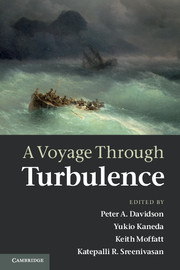Book contents
- Frontmatter
- Contents
- List of contributors
- Preface
- 1 Osborne Reynolds: a turbulent life
- 2 Prandtl and the Göttingen school
- 3 Theodore von Kármán
- 4 G.I. Taylor: the inspiration behind the Cambridge school
- 5 Lewis Fry Richardson
- 6 The Russian school
- 7 Stanley Corrsin
- 8 George Batchelor: the post-war renaissance of research in turbulence
- 9 A.A. Townsend
- 10 Robert H. Kraichnan
- 11 Satish Dhawan
- 12 Philip G. Saffman
- 13 Epilogue: a turbulence timeline
- References
2 - Prandtl and the Göttingen school
Published online by Cambridge University Press: 07 October 2011
- Frontmatter
- Contents
- List of contributors
- Preface
- 1 Osborne Reynolds: a turbulent life
- 2 Prandtl and the Göttingen school
- 3 Theodore von Kármán
- 4 G.I. Taylor: the inspiration behind the Cambridge school
- 5 Lewis Fry Richardson
- 6 The Russian school
- 7 Stanley Corrsin
- 8 George Batchelor: the post-war renaissance of research in turbulence
- 9 A.A. Townsend
- 10 Robert H. Kraichnan
- 11 Satish Dhawan
- 12 Philip G. Saffman
- 13 Epilogue: a turbulence timeline
- References
Summary
Introduction
In the early decades of the 20th century Göttingen was the center for mathematics. The foundations were laid by Carl Friedrich Gauss (1777–1855) who from 1808 was head of the observatory and professor for astronomy at the Georg August University (founded in 1737). At the turn of the 20th century, the well-known mathematician Felix Klein (1849–1925), who joined the University in 1886, established a research center and brought leading scientists to Göttingen. In 1895 David Hilbert (1862–1943) became Chair of Mathematics and in 1902 Hermann Minkowski (1864–1909) joined the mathematics department. At that time, pure and applied mathematics pursued diverging paths, and mathematicians at Technical Universities were met with distrust from their engineering colleagues with regard to their ability to satisfy their practical needs (Hensel, 1989). Klein was particularly eager to demonstrate the power of mathematics in applied fields (Prandtl, 1926b; Manegold, 1970). In 1905 he established an Institute for Applied Mathematics and Mechanics in Göttingen by bringing the young Ludwig Prandtl (1875–1953) and the more senior Carl Runge (1856–1927), both from the nearby Hanover. A picture of Prandtl at his water tunnel around 1935 is shown in Figure 2.1.
Prandtl had studied mechanical engineering at the Technische Hochschule (TH, Technical University) in Munich in the late 1890s. In his studies he was deeply influenced by August Föppl (1854–1924), whose textbooks on technical mechanics became legendary.
- Type
- Chapter
- Information
- A Voyage Through Turbulence , pp. 40 - 100Publisher: Cambridge University PressPrint publication year: 2011
References
- 20
- Cited by

